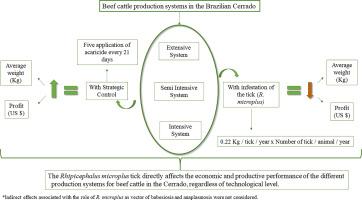Agricultural Systems ( IF 6.6 ) Pub Date : 2021-08-20 , DOI: 10.1016/j.agsy.2021.103247 Maria Paula Cavuto Abrão Calvano 1 , Ricardo Carneiro Brumatti 2 , Jacqueline Cavalcante Barros 3, 4 , Marcos Valério Garcia 4, 5 , Kauê Rodriguez Martins 4, 6 , Renato Andreotti 3, 4

|
CONTEXT
Models are important tools to assess the impacts of tick infestation on the economic performance of different beef cattle production systems. The information from these simulations can be used by producers to evaluate, compare and make decisions about strategic measures to control the tick Rhipicephalus microplus, which cause significant production losses for the beef cattle production chain.
OBJECTIVE
The aim of this study was to adapt a model to estimate and compare the economic losses related to the infestation of the tick R. microplus in cattle production systems under grazing conditions with different technological standards in the Brazilian Cerrado biome.
METHODS
Three production systems were simulated, characterized as extensive, semi-intensive and intensive systems, based on zootechnical indexes and parameters of the production systems under evaluation. To compare the systems, they were divided into systems with tick infestation and strategic control.
RESULTS AND CONCLUSIONS
For the cattle categories intended for replacement and slaughter, each female in the infested systems had an individual loss of 19 kg of live weight (LW), whereas males aged 24, 36, and ≥ 36 months had an individual loss of 39, 68, and 92 kg LW, respectively, compared to the control systems. The economic difference in gross profit between the extensive system with control and with infestation was US $ 22, 619.00. The semi- intensive system with infestation showed a difference in gross profit of US $13, 902.00 relative to the semi-intensive system with control, and the intensive system with infestation showed in gross profit difference of US $28, 290.00 compared to the intensive system with control. Productivity indicators were higher as the technological level increased, but they were lower in systems with infestation.
SIGNIFICANCE
This means that losses in productivity and efficiency associated with R. microplus infestation economically impact the livestock production chain in the Brazilian Cerrado.
中文翻译:

巴西塞拉多不同肉牛生产系统中 Rhipicephalus microplus 侵染的生物经济模拟
语境
模型是评估蜱虫感染对不同肉牛生产系统经济绩效影响的重要工具。生产者可以使用来自这些模拟的信息来评估、比较和决策控制蜱Rhipicephalus microplus 的战略措施,这会导致肉牛生产链的重大生产损失。
目标
本研究的目的是采用一个模型来估计和比较与巴西塞拉多生物群落中不同技术标准的放牧条件下养牛生产系统中蜱R. microplus侵染相关的经济损失。
方法
根据评价中的生产系统的畜牧学指标和参数,模拟了三个生产系统,分别是粗放、半集约和集约化系统。为了比较这些系统,它们被分为蜱虫侵扰系统和战略控制系统。
结果和结论
对于用于替代和屠宰的牛类别,感染系统中的每头雌性个体损失了 19 公斤活重 (LW),而 24、36 和 36 个月以上的雄性个体损失了 39、68、和 92 kg LW,分别与对照系统相比。具有控制和侵染的粗放系统在毛利润方面的经济差异为 22 美元,619.00 美元。有虫害的半精养系统与有控制的半精养系统相比,毛利润差异为 13, 902.00 美元,有虫害的精养系统与有控制的精养系统相比,毛利润差异为 28, 290.00 美元。控制。随着技术水平的提高,生产力指标较高,但在有侵扰的系统中较低。
意义
这意味着与R. microplus侵染相关的生产力和效率损失会对巴西塞拉多的畜牧生产链产生经济影响。


























 京公网安备 11010802027423号
京公网安备 11010802027423号